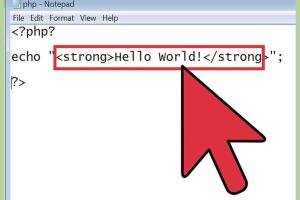Mastering PHP: A Comprehensive Guide to Writing Effective PHP Scripts

-
Quick Links:
- 1. Introduction to PHP
- 2. Setting Up Your PHP Environment
- 3. Basic Syntax of PHP
- 4. Data Types and Variables
- 5. Control Structures
- 6. Functions in PHP
- 7. Working with Databases
- 8. Error Handling in PHP
- 9. Best Practices for Writing PHP Scripts
- 10. Real-World Examples and Case Studies
- 11. Conclusion
- 12. FAQs
1. Introduction to PHP
PHP, or Hypertext Preprocessor, is a widely-used open-source server-side scripting language that is especially suited for web development. PHP allows developers to create dynamic content, manage databases, and build complete web applications. Its ease of use and flexibility have made it a popular choice among developers worldwide.
In this comprehensive guide, we'll walk you through the fundamental concepts of writing PHP scripts, providing you with the knowledge and skills to create your applications effectively.
2. Setting Up Your PHP Environment
Before you can start writing PHP scripts, you need to set up a development environment. Here are the steps you can follow:
- Install a Local Server: You can use packages like XAMPP, MAMP, or WAMP that provide Apache, MySQL, and PHP in one installation.
- Choose a Text Editor: Popular choices include Visual Studio Code, Sublime Text, or PHPStorm.
- Create Your First PHP File: Open your text editor and create a new file named
index.php.
Test your setup by placing the file in your server’s root directory and accessing it through your browser.
3. Basic Syntax of PHP
PHP scripts can be embedded into HTML. Here's a simple example:
<?php
echo "Hello, World!";
?>This script outputs "Hello, World!" when accessed in a web browser. PHP code is written between the <?php and ?> tags.
4. Data Types and Variables
PHP supports several data types including:
- Strings: Textual data.
- Integers: Whole numbers.
- Floats: Decimal numbers.
- Booleans: True or false values.
- Arrays: Collections of values.
Variables in PHP are declared with a dollar sign ($) followed by the variable name. For example:
$name = "John";5. Control Structures
Control structures allow you to dictate the flow of your scripts. Here are the most common types:
- If statements: Used for conditional execution.
- Switch statements: A multi-branch conditional.
- Loops: Execute a block of code multiple times (e.g.,
for,while).
6. Functions in PHP
Functions are reusable blocks of code that perform a specific task. You can create custom functions as follows:
function greet($name) {
return "Hello, " . $name;
}This function greets a user by name. You can call it using greet("Alice");.
7. Working with Databases
PHP works seamlessly with databases, particularly MySQL. To connect to a database, you can use the following example:
$connection = new mysqli("localhost", "username", "password", "database");
if ($connection->connect_error) {
die("Connection failed: " . $connection->connect_error);
}From here, you can execute queries to retrieve or manipulate data.
8. Error Handling in PHP
Effective error handling is crucial for building robust PHP applications. You can use try-catch blocks to handle exceptions:
try {
// Code that may throw an exception
} catch (Exception $e) {
echo 'Caught exception: ', $e->getMessage();
}9. Best Practices for Writing PHP Scripts
To ensure your PHP scripts are efficient and maintainable, consider the following best practices:
- Use meaningful variable names.
- Comment your code for clarity.
- Follow a consistent coding style.
- Utilize version control systems like Git.
10. Real-World Examples and Case Studies
To illustrate the power of PHP, let’s explore a couple of case studies:
Case Study 1: Building a Simple Blog
Utilizing PHP and MySQL, you can create a simple blog application that allows users to post articles, comment, and view posts.
Case Study 2: E-commerce Site
PHP can be used to build complex e-commerce platforms that manage user accounts, product listings, and transactions.
11. Conclusion
Writing PHP scripts is an essential skill for web developers. By following the guidelines outlined in this article, you’ll be able to create dynamic and interactive applications. Practice regularly, and keep learning to stay ahead in the ever-evolving world of PHP development.
12. FAQs
1. What is PHP used for?
PHP is primarily used for server-side web development to create dynamic web pages.
2. Is PHP easy to learn?
Yes, PHP is considered beginner-friendly and has extensive documentation and community support.
3. Can I use PHP for command-line scripting?
Yes, PHP can be used for command-line scripting as well as web development.
4. What are some popular PHP frameworks?
Popular frameworks include Laravel, Symfony, and CodeIgniter.
5. How does PHP handle error reporting?
PHP has built-in error reporting features that can be configured to display or log errors.
6. Can PHP be used for web APIs?
Yes, PHP can be used to build RESTful APIs for web applications.
7. What are the security risks in PHP?
Common risks include SQL injection, cross-site scripting (XSS), and session hijacking.
8. How do I connect to a MySQL database in PHP?
You can connect using the MySQLi extension or PDO (PHP Data Objects).
9. What are cookies and sessions in PHP?
Cookies are small files stored on the client side, while sessions are server-side storage for user data.
10. Where can I find PHP resources for further learning?
Resources include the official PHP documentation (https://www.php.net/docs.php), online courses, and community forums.